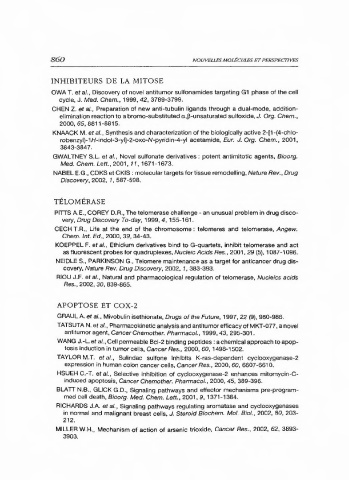Page 902 - Traité de chimie thérapeutique 6 Médicaments antitumoraux
P. 902
860 NOUVELLES MOLÉCULES ETPERSPECTIVES
INHIBITEURS DE LA MITOSE
OWA T. et al., Discovery of novel antitumor sulfonamides targeting G1 phase of the cell
cycle, J. Mead. Chem., 1999, 42, 3789-3799.
CHEN Z. et al., Preparation of new anti-tubulin ligands through a dual-mode, addition-
elimination reaction to a bromo-substituted o.,!3-unsaturated sulfoxide, J. Org. Chem.,
2000, 65, 8811-8815.
KNAACK M. et al., Synthesis and characterization of the biologically active 2-[1-(4-chlo-
robenzyl)-1H-indol-3-y/]-2-oxo-N-pyridin-4-yl acetamide, Eur. J. Org. Chem., 2001,
3843-3847.
GWALTNEY S.L. et al., Novel sulfonate derivatives: potent antimitotic agents, Bioorg.
Med. Chem. Lett., 2001, 11, 1671-1673.
NABEL E.G., CDKS et CKIS : molecular targets for tissue remodelling, Nature Rev., Drug
Discovery, 2002, 1, 587-598.
TÉLOMÉRASE
PITTS A.E., COREY D.R., The telomerase challenge - an unusual problem in drug disco-
very, Drug Discovery To-day, 1999, 4, 155-161.
CECH T.R., Lite at the end of the chromosome : telomeres and telomerase, Angew.
Chem. /nt. Ed., 2000, 39, 34-43.
KOEPPEL F. et al., Ethidium derivatives bind to G-quartets, inhibit telomerase and act
as fluorescent probes for quadruplexes, Nuc/eic Acids Res., 2001, 29 (5), 1087-1096.
NEIDLE S., PARKINSON G., Telomere maintenance as a target for anticancer drug dis-
covery, Nature Rev. Drug Discovery, 2002, 1, 383-393.
RIOU J.F. et al., Natural and pharmacological regulation of telomerase, Nucleics acids
Res., 2002, 30, 839-865.
APOPTOSE ET COX-2
GRAUL A. et al., Mivobulin isethionate, Drugs of the Future, 1997, 22 (9), 980-986.
TATSUTA N. et al., Pharmacokinetic analysis and antitumor efficacy of MKT-077,a novel
antitumor agent, Cancer Chemother. Pharmaco/., 1999, 43, 295-301.
WANG J.-L. et al., Cell permeable Bcl-2 binding peptides : a chemical approach to apop-
tosis induction in tumor cells, Cancer Res., 2000, 60, 1498-1502.
TAYLOR M.T. et al., Sulindac sulfone inhibits K-ras-dependent cyclooxygenase-2
expression in human colon cancer cells, Cancer Res., 2000, 60, 6607-6610.
HSUEH C.-T. et al., Selective inhibition of cyclooxygenase-2 enhances mitomycin-C-
induced apoptosis, Cancer Chemother. Pharmacol., 2000, 45, 389-396.
BLATT N.B., GLICK G.D., Signaling pathways and effector mechanisms pre-program-
med cell death, Bioorg. Med. Chem. Lett., 2001, 9, 1371-1384.
RICHARDS J.A. et al., Signaling pathways regulating aromatase and cyclooxygenases
in normal and malignant breast cells, J. Steroid Biochem. Mol. Bio/., 2002, 80, 203-
212.
MILLER W.H., Mechanism of action of arsenic trioxide, Cancer Res., 2002, 62, 3893-
3903.

